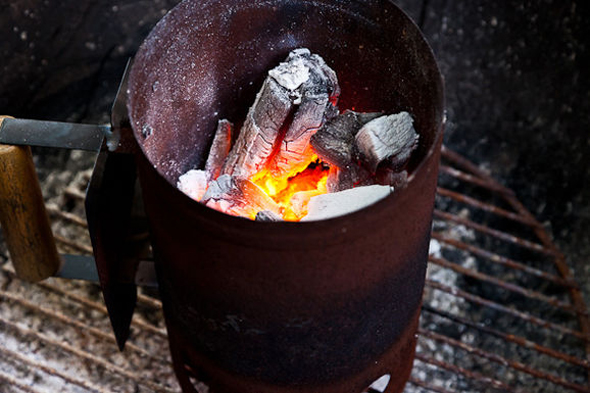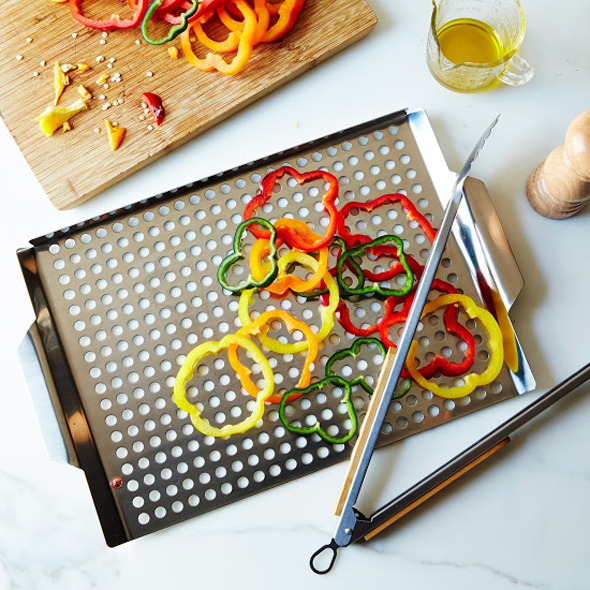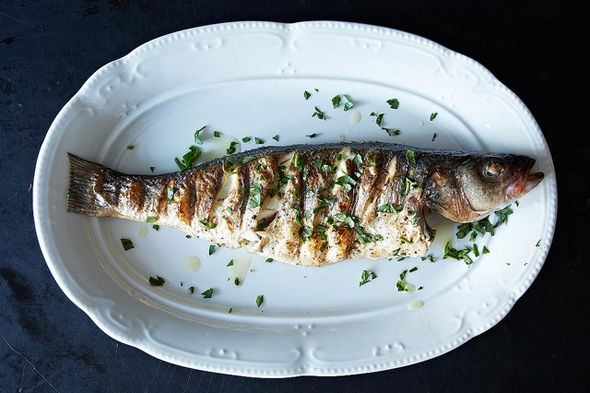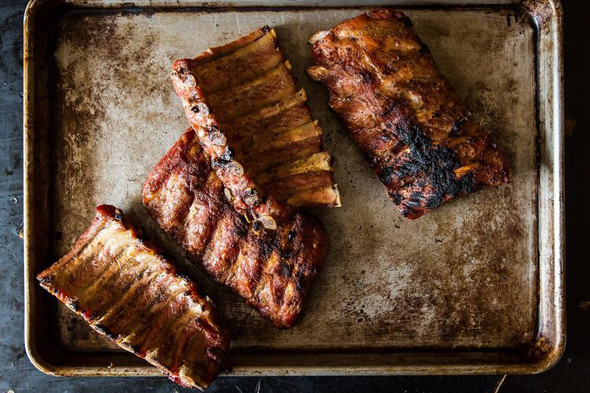10 essential grilling tools
Fire up the chimney starter and pull on some welder's gloves — grilling is serious stuff


When you make a purchase through links on our site, we may earn a commission
Grilling is the world's oldest and most universal cooking method. So it doesn't require a lot of elaborate equipment, but don't tell the typical American griller; we love our gear. I'm as guilty as the next: When I couldn't find a grill tool on the market that did quite what I wanted it to, I designed one myself.
The bottom line, though, is that you need only five basic tools, all of which are widely available, to accomplish pretty much anything on the grill. Some specialized gadgets can also help you to up your game and make grilling a lot more exciting. Today, I'm sharing both, plus a few tips to make your grilling easier.
The Week
Escape your echo chamber. Get the facts behind the news, plus analysis from multiple perspectives.

Sign up for The Week's Free Newsletters
From our morning news briefing to a weekly Good News Newsletter, get the best of The Week delivered directly to your inbox.
From our morning news briefing to a weekly Good News Newsletter, get the best of The Week delivered directly to your inbox.
The Essentials:
1. Chimney starter
If you're really serious about grilling, you'll want to cook over charcoal. It burns hotter and drier than propane, producing a better char and a more savory crust. Plus, it's easy to smoke on a charcoal grill but it's virtually impossible to do so over gas. The best way to light charcoal is in a chimney starter, which ignites the coals quickly (in 15 to 20 minutes) and evenly (with no unlit coals on the periphery) without requiring lighter fluid, which can leave a petroleum taste. Remember that natural lump charcoal gives you a cleaner burn than briquettes.

2. Grill hoe (or garden hoe)
A free daily email with the biggest news stories of the day – and the best features from TheWeek.com
Unlike gas grills, charcoal grills have no burner knobs; one of the best ways to control the heat is by building your fire smartly. For direct grilling, I recommend a three-zone fire: a thick layer of coals at the back of the grill to give you a high heat for searing; a thinner layer in the center of the grill to give you a moderate heat for cooking; and no coals in the front to create a "safety" zone (an ember-free area where you can move food to dodge flare-ups).
For indirect grilling, rake the coals into mounds at opposite sides of the grill, and cook your food in the center. Over the years, I've found the best tool for moving the coals to be a garden hoe or grill hoe. Tip: Make sure the hoe handle is wood — burning plastic doesn't smell all that terrific.
3. Grill brush
If you've watched my shows or taken my classes, you've heard my grill master's mantra: "Keep it hot. Keep it clean. Keep it lubricated." That is: Start with a hot fire. Brush your grill grate clean with a stiff wire brush. And oil it with a tightly folded paper towel dipped in oil and drawn across the bars of the grate with a pair of tongs. (This last step also mops up the rare stray brush bristle.)
I like a brush with steel bristles on one side (for cast iron and stainless steel grates) and brass bristles on the other side (for more delicate surfaces, like porcelainized enamel grates). A long handle helps, too, to keep you away from the heat. I'm partial to my Ultimate Grill Brush, but I also like the Grill Daddy, which has a water reservoir, so you can steam-clean the grate. Tip: Restaurant supply houses are a good source for grill brushes.

4. Long-handled, spring-loaded tongs
Another of my grill mantras is "Turn, don't stab," meaning that it's better to turn steaks, chops, and even burgers with tongs than to stab them with a barbecue fork, which punctures the meat.
Look for sturdy, spring-loaded tongs with rolled or reinforced steel arms (so they don't buckle when you go to pick up a whole chicken or pork shoulder) that is at least 16-inches long (to keep your hands away from the fire). When I designed my Best of Barbecue tongs, I mounted a miniature flashlight on one arm so you can see what you're grilling at night.
5. Instant-read meat thermometer:
Unless you're Aaron Franklin or John Lewis (Austin's reigning brisket maestros), there's only one reliable way to tell when a large hunk of meat is properly cooked, and that's to check its internal temperature using an instant-read thermometer. The Thermopen has a needle-thin probe for easy insertion (it folds back into the handle when you're not using it) and a digital readout that indicates the precise temperature to the degree. Tip: When checking the doneness of a steak or burger, insert the thermometer probe through the side, not the top — you'll get a more accurate reading.

Other cool tools that will help you up your game:
6. Suede grill gloves or welder's gloves
By its very nature, grilling requires handling lots of hot objects — from lit chimney starters to hot grill grates. To protect your hands, you want heavy leather or suede gloves — preferably with long sleeves to shield your forearms from the sparks and heat. Tip: When not using my own, I buy gloves from welder's supply houses.
7. Grid lifter
At some point in the grilling or smoking process, you'll need to lift the screaming hot grill grate to add fresh charcoal or wood smoking chips. (The task is particularly unwieldy on ceramic kamado cookers, which rarely have handles on the grate.) Enter the grid lifter, which helps you lift the grate without burning your fingers.

8. Grill basket
If you grill in North America, you may be surprised to learn that across vast swaths of Planet Barbecue, grills don't come with grates; instead, you place the food to be grilled in a flat wire basket and position it over the coals. But even if your grill has a grate, a grill basket can help you grill fragile fish or vegetables (like sole or tomatoes), or small pieces of food that might otherwise be hard to handle (like shrimp or okra).
Grill baskets come in myriad sizes and shapes — some are specialized for particular foods, like whole trout (fish baskets) or miniature burgers (slider baskets). Whichever one you pick, the beauty of a grill basket is that you turn it, not the food. Just remember to oil the basket with a folded paper towel dipped in oil — or spray oil on it — before adding the food.

9. Rib rack:
Ribs come with an inherent paradox: The ubiquitous 22 1/2-inch kettle grill comfortably holds two racks of baby back ribs or spareribs, but most cookouts require at least four racks — enough to serve six to eight people. Thankfully we have the rib rack, which holds the slabs upright so you can get four on a single grill. An added advantage: The vertical position helps drain off excess fat.
10. Meat claws or a meat shredder
Pulled pork is the high holy of Carolina barbecue, and those who make it for a living have developed asbestos fingers for shredding the meat by hand. (Okay, maybe they wear a pair of cotton gloves under plastic gloves for a modicum of protection.) For the rest of us, the sharp prongs of the Bear Paw help shred the meat without burning your fingers.
This article was originally published on Food52.com: Steven Raichlen's 10 essential grilling tools
More from Food52...
-
 Political cartoons for December 14
Political cartoons for December 14Cartoons Sunday's political cartoons include a new White House flag, Venezuela negotiations, and more
-
 Heavenly spectacle in the wilds of Canada
Heavenly spectacle in the wilds of CanadaThe Week Recommends ‘Mind-bending’ outpost for spotting animals – and the northern lights
-
 Facial recognition: a revolution in policing
Facial recognition: a revolution in policingTalking Point All 43 police forces in England and Wales are set to be granted access, with those against calling for increasing safeguards on the technology